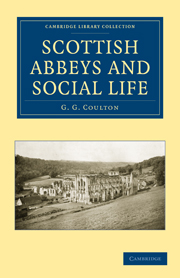Book contents
- Frontmatter
- Contents
- LIST OF ILLUSTRATIONS
- Preface
- Chapter I Celtic Monachism
- Chapter II The Monastic Rules
- Chapter III Monastic Revenues
- Chapter IV How Endowments Came (I)
- Chapter V How Endowments Came (II)
- Chapter VI Monks and Parishes (I)
- Chapter VII Monks and Parishes (II)
- Chapter VIII Charity (I)
- Chapter IX Charity (II)
- Chapter X Monk and Peasant (I)
- Chapter XI Monk and Peasant (II)
- Chapter XII Monastic Housekeeping
- Chapter XIII Church and Scriptorium
- Chapter XIV The Monastic Chronicler
- Chapter XV Schools
- Chapter XVI Art and Learning
- Chapter XVII Professions and Business
- Chapter XVIII Visitation (I)
- Chapter XIX Visitation (II)
- Chapter XX A Voice from the Cloister
- Chapter XXI Conclusion
- Appendixes
- List of Authorities
- Index
Chapter XII - Monastic Housekeeping
Published online by Cambridge University Press: 05 August 2011
- Frontmatter
- Contents
- LIST OF ILLUSTRATIONS
- Preface
- Chapter I Celtic Monachism
- Chapter II The Monastic Rules
- Chapter III Monastic Revenues
- Chapter IV How Endowments Came (I)
- Chapter V How Endowments Came (II)
- Chapter VI Monks and Parishes (I)
- Chapter VII Monks and Parishes (II)
- Chapter VIII Charity (I)
- Chapter IX Charity (II)
- Chapter X Monk and Peasant (I)
- Chapter XI Monk and Peasant (II)
- Chapter XII Monastic Housekeeping
- Chapter XIII Church and Scriptorium
- Chapter XIV The Monastic Chronicler
- Chapter XV Schools
- Chapter XVI Art and Learning
- Chapter XVII Professions and Business
- Chapter XVIII Visitation (I)
- Chapter XIX Visitation (II)
- Chapter XX A Voice from the Cloister
- Chapter XXI Conclusion
- Appendixes
- List of Authorities
- Index
Summary
The monks of all ages preached to the peasant, and the early monks had taken very literally to themselves, that Pauline precept: “Having food and raiment, let us be therewith content”. We may now enquire how far the settled and endowed monk, the average monk of the last few centuries before the Reformation, could have claimed to take this prescription literally.
Neither the Benedictine nor the Augustinian Rule prescribes any violent asceticism in the matter of food and drink, apart from those fasts which strict churchfolk often tried to follow even outside the cloister, especially women. St Benedict goes into detail; we can see that he granted his brethren the diet of an Italian peasant of his own day, amply sufficient to keep up bodily vigour, but plain and monotonous according to modern standards in colder climates. He insists strongly on abstinence from butcher's meat, except for the sick; and the Augustinian Rule, though less strict on this point, was sometimes interpreted in that direction. Contemporary satirists amused themselves with drawing contrasts between monastic theory and practice in this field; but let us neglect these for the present, and see what the monks themselves have to say. Here, again, Scottish records are less abundant than in most other countries; but they tell us a good deal that is significant.
- Type
- Chapter
- Information
- Scottish Abbeys and Social Life , pp. 142 - 153Publisher: Cambridge University PressPrint publication year: 2010First published in: 1933

